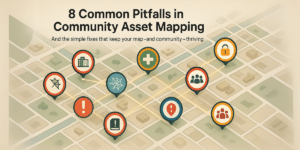Building a Strong Coalition Means Letting Go of the Reins

When building a coalition, you should set aside your preconceived conceptions and positions concerning your goals, priorities, and policies. Remaining open-minded is one of a network leader’s best tools. After all, a network’s access to different ideas and ways of thinking is one of its biggest strengths and assets. Trying to dictate how the coalition will work together or what its priorities are, slows the generative flow of ideas that makes a network beneficial in the first place. Bringing together unlikely partners with access to different kinds of information generates robust new solutions that would never be possible alone. In network science and systems thinking, we call this emergence.
Making Space for Emergence in a Coalition of Community Partners
Emergence is a central tenet and process in networks and systems. It occurs when an entity develops properties its parts do not have on their own, properties or behaviors which emerge when the components interact in the broader whole. For example, all body organs work together to create a human being with properties like life, thoughts, and emotions that only emerge when the multiple systems work together.
This same principle operates in any network or coalition of partners. Each participant provides diverse ways of thinking, access to unique information, and different priorities and assumptions that interact with one another. When network members come to the table hardened with a pre-determined goal or focus – an idea that they know the solution – their mindset acts as a dam or barrier, blocking different perspectives from intermingling and preventing the emergence of new ideas. Spend time in your coalition, fostering a sense of open-mindedness to gain the full benefits of collaboration.
Alignment Based on Interests and Values – Not Positions and Politics
How do we build a network with any semblance of alignment if the key is letting go? What is the point of working together if we all have different goals and priorities? The key is to take a lesson from interest-based negotiation and focus on underlying values, assumptions, and interests, instead of focusing on the surface-level positions, priorities, and goals we think about most of the time.
For example, a Rancher and Environmental Nonprofit disagree on many political and policy positions and assumptions. One supports a carbon tax, while the other aggressively opposes it. However, they have underlying values and interests which align – an appreciation for the environment and a desire to be good stewards of the land. Focusing on these underlying shared values while allowing your plans and priorities to shift, flex, and merge with those of the group is the key to facilitating emergent solutions and ideas in your coalition.
Exceptions to the Rule: Not all Networks are the Same
Remember that not all networks and coalitions are equal. They each have a unique history and community context which comes into play. Some networks form with an explicit goal, often pre-determined by a funder or other external stakeholders. When it is impossible to let go of everything, do what you can to create space for emergent dialogue. While goals may already be set in stone, there are many ways to meet them… a perfect situation for an emergent solution from the group!

About the Author: Alex Derr, M.P.A.
Director of Marketing & Communications
Alex joined VNL in 2017, originally supporting our events. He now helps manages our communications and marketing strategy and content development work. Alex creates blogs, infographics, reports, and other content while managing our web and social media presence. He also runs our email marketing campaigns, tracks analytics, and conducts market research to drive our strategy. He supports our entire team with copywriting, graphic design and research, and helps with events, webinars, demos, and other online learning. When he isn’t at work Alex spends his time climbing 14ers (30 done, 28 to go!) and blogging on his own website, The Next Summit Blog.





